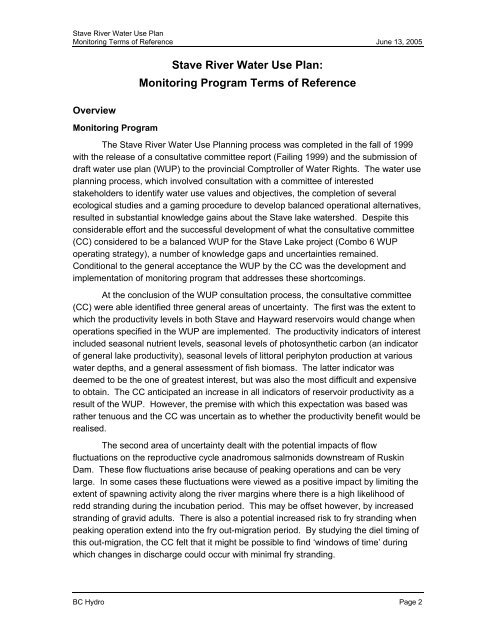Stave River Water Use Plan - BC Hydro
Stave River Water Use Plan - BC Hydro
Stave River Water Use Plan - BC Hydro
Create successful ePaper yourself
Turn your PDF publications into a flip-book with our unique Google optimized e-Paper software.
<strong>Stave</strong> <strong>River</strong> <strong>Water</strong> <strong>Use</strong> <strong>Plan</strong><br />
Monitoring Terms of Reference June 13, 2005<br />
Overview<br />
Monitoring Program<br />
<strong>Stave</strong> <strong>River</strong> <strong>Water</strong> <strong>Use</strong> <strong>Plan</strong>:<br />
Monitoring Program Terms of Reference<br />
The <strong>Stave</strong> <strong>River</strong> <strong>Water</strong> <strong>Use</strong> <strong>Plan</strong>ning process was completed in the fall of 1999<br />
with the release of a consultative committee report (Failing 1999) and the submission of<br />
draft water use plan (WUP) to the provincial Comptroller of <strong>Water</strong> Rights. The water use<br />
planning process, which involved consultation with a committee of interested<br />
stakeholders to identify water use values and objectives, the completion of several<br />
ecological studies and a gaming procedure to develop balanced operational alternatives,<br />
resulted in substantial knowledge gains about the <strong>Stave</strong> lake watershed. Despite this<br />
considerable effort and the successful development of what the consultative committee<br />
(CC) considered to be a balanced WUP for the <strong>Stave</strong> Lake project (Combo 6 WUP<br />
operating strategy), a number of knowledge gaps and uncertainties remained.<br />
Conditional to the general acceptance the WUP by the CC was the development and<br />
implementation of monitoring program that addresses these shortcomings.<br />
At the conclusion of the WUP consultation process, the consultative committee<br />
(CC) were able identified three general areas of uncertainty. The first was the extent to<br />
which the productivity levels in both <strong>Stave</strong> and Hayward reservoirs would change when<br />
operations specified in the WUP are implemented. The productivity indicators of interest<br />
included seasonal nutrient levels, seasonal levels of photosynthetic carbon (an indicator<br />
of general lake productivity), seasonal levels of littoral periphyton production at various<br />
water depths, and a general assessment of fish biomass. The latter indicator was<br />
deemed to be the one of greatest interest, but was also the most difficult and expensive<br />
to obtain. The CC anticipated an increase in all indicators of reservoir productivity as a<br />
result of the WUP. However, the premise with which this expectation was based was<br />
rather tenuous and the CC was uncertain as to whether the productivity benefit would be<br />
realised.<br />
The second area of uncertainty dealt with the potential impacts of flow<br />
fluctuations on the reproductive cycle anadromous salmonids downstream of Ruskin<br />
Dam. These flow fluctuations arise because of peaking operations and can be very<br />
large. In some cases these fluctuations were viewed as a positive impact by limiting the<br />
extent of spawning activity along the river margins where there is a high likelihood of<br />
redd stranding during the incubation period. This may be offset however, by increased<br />
stranding of gravid adults. There is also a potential increased risk to fry stranding when<br />
peaking operation extend into the fry out-migration period. By studying the diel timing of<br />
this out-migration, the CC felt that it might be possible to find ‘windows of time’ during<br />
which changes in discharge could occur with minimal fry stranding.<br />
<strong>BC</strong> <strong>Hydro</strong> Page 2
















